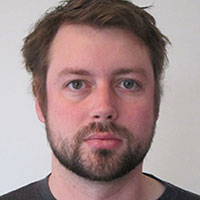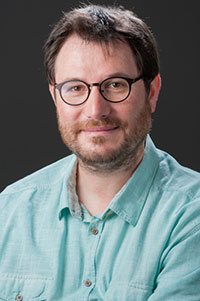 Thomas Laville. Muséum national d’Histoire naturelle, Centre de Recherche en Paléontologie-Paris (UMR7207), MNHN-Sorbonne Université-CNRS, Paris, France and Biogéosciences, UMR 6282- CNRS, Université Bourgogne Franche-Comté, EPHE, Dijon, France. Corresponding author. thomas.laville@ecomail.fr
Thomas Laville. Muséum national d’Histoire naturelle, Centre de Recherche en Paléontologie-Paris (UMR7207), MNHN-Sorbonne Université-CNRS, Paris, France and Biogéosciences, UMR 6282- CNRS, Université Bourgogne Franche-Comté, EPHE, Dijon, France. Corresponding author. thomas.laville@ecomail.fr
Thomas Laville is a teaching and research assistant at the Université de Bourgogne, Dijon, France. He recently completed his PhD thesis on the origin, evolution and diversification of thylacocephalans at the Muséum national d'Histoire naturelle, Paris (Centre de Recherche en Paléontologie - Paris, CR2P). His research focuses on the anatomy, evolution, and palaeobiodiversity of pancrustaceans, especially of thylacocephalans.
![]()
 Thomas A. Hegna. Department of Geology and Environmental Science, State University of New York at Fredonia, New York, USA thomas.hegna@fredonia.edu
Thomas A. Hegna. Department of Geology and Environmental Science, State University of New York at Fredonia, New York, USA thomas.hegna@fredonia.edu
Dr. Thomas Hegna grew up in western Iowa and attended the University of Iowa where he fell in love with invertebrate paleontology. He graduated in the spring of 2004 with honors and high distinction in Geoscience (B.S.) with minors in English and Philosophy. Dr. Hegna stayed at the University of Iowa for his M.S., graduating in the fall of 2006 after completing a project on the systematics and phylogeny of a fauna of upper Cambrian trilobites. He then moved on to Yale University where he completed his thesis on branchiopod crustacean phylogeny and their fossil record in the spring of 2012. He taught at Western Illinois University from the fall of 2011 to the spring of 2019. During the summer of 2019, he moved to Fredonia to teach in the Geology & Environmental Sciences Department at SUNY Fredonia. He continues to study both the fossil record of trilobites and early crustaceans. He has 40 published peer-reviewed papers and book chapters and nearly 90 conference presentations.
![]()
 Marie-Béatrice Forel. Muséum national d’Histoire naturelle, Centre de Recherche en Paléontologie-Paris (UMR7207), MNHN-Sorbonne Université-CNRS, Paris, France. marie-beatrice.forel@mnhn.fr
Marie-Béatrice Forel. Muséum national d’Histoire naturelle, Centre de Recherche en Paléontologie-Paris (UMR7207), MNHN-Sorbonne Université-CNRS, Paris, France. marie-beatrice.forel@mnhn.fr
Marie-Béatrice Forel is Assistant Professor and Curator of micropalaeontology collections in the Muséum national d'Histoire naturelle, Paris (Centre de Recherche en Paléontologie - Paris, CR2P). She received a Master degree from the Bordeaux 1 University and PhD from the Université Pierre et Marie Curie (Paris 6). Her research focuses on taxonomy, palaeoecology and diversity dynamics of Permian and Triassic marine ostracods worldwide.
![]()
 Simon Darroch. Department of Earth and Environmental Sciences, Vanderbilt University, Nashville, Tennessee, USA. simon.a.darroch@vanderbilt.edu
Simon Darroch. Department of Earth and Environmental Sciences, Vanderbilt University, Nashville, Tennessee, USA. simon.a.darroch@vanderbilt.edu
Simon Darroch is an Assistant Professor in Paleontology at Vanderbilt University. His research focusses on understanding major changes in the complexity of Earth-Life systems, in particular over the Ediacaran-Cambrian transition. He currently runs the microCT facility in the Department of Earth and Environmental Sciences at Vanderbilt.
![]()
 Sylvain Charbonnier. Muséum national d’Histoire naturelle, Centre de Recherche en Paléontologie-Paris (UMR7207), MNHN-Sorbonne Université-CNRS, Paris, France. sylvain.charbonnier@mnhn.fr
Sylvain Charbonnier. Muséum national d’Histoire naturelle, Centre de Recherche en Paléontologie-Paris (UMR7207), MNHN-Sorbonne Université-CNRS, Paris, France. sylvain.charbonnier@mnhn.fr
Sylvain Charbonnier, professor of palaeontology and chief curator of the palaeontological collections at the Muséum national d’Histoire naturelle, Paris (France) studies exceptionally preserved fossils from Konservat-Lagerstätten (Montceau-les-Mines, La Voulte-sur-Rhône, Solnhofen, Canjuers, Cerin, Hadjoula, Hakel). His main scientific interests focus on Mesozoic marine arthropods (crustaceans, thylacocephalans, pycnogonids) and the reconstruction of their palaeoecosystems. He was president of the Société Géologique de France between 2016 and 2020.

